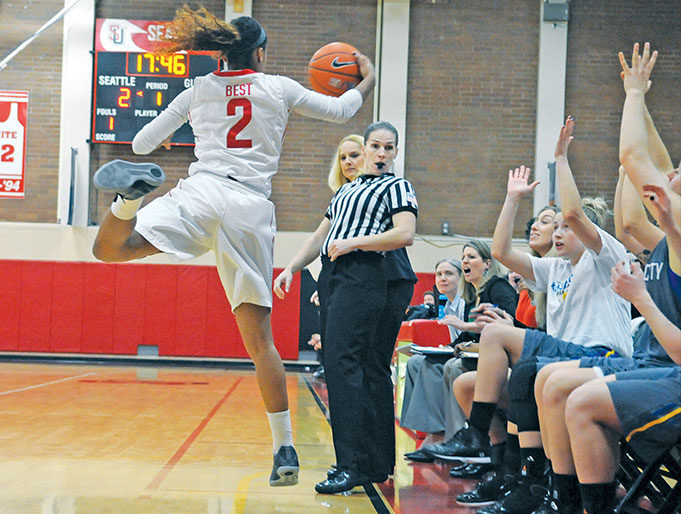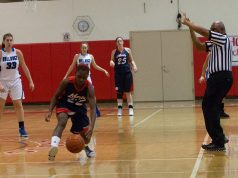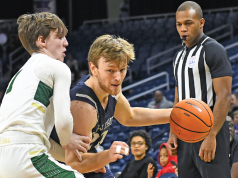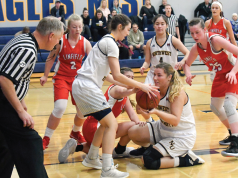One of the great things about being a basketball official is having to make quick and instantaneous decisions on many different types of plays that are happening at a very fast pace. Take the out-of-bounds play for example. Some out-of-bounds situations are relatively easy and innocuous calls to make. But on the other hand, some out-of-bounds rulings can be among the toughest and perhaps the most significant rulings you make the entire game.
Imagine there are 10 seconds left in a one-point game. As the lead official, you are completely focused on your primary coverage area. You correctly have closed down, angled slightly toward the free-throw lane while watching rebounding action under the basket. The ball is furiously ricocheting off hands and fingers like a steel ball in a pinball machine. Suddenly the ball is tapped out of bounds. The players aren’t sure who committed the violation. As much as the coaches will try to influence your call, they don’t really know. That is a huge moment in the game and you are expected to come in with a correct call.
Sue Blauch, a WNBA and Division I women’s official, uses a sound method of officiating when she is required to make an out-of-bounds ruling. “Many out-of-bounds calls require laser-focused vision,” Blauch explains. “Watching the ball make contact with the fingertips, recognizing the ball changing direction or observing the spin on the ball are all clues we must use to evaluate whether or not the ball was deflected in any given situation.”
Blauch makes some excellent points, but there is another factor of equal importance. Officials must stay in proper position at all times. That means constantly moving with the ball in order to keep the correct angles to get the best look if the ball is tapped out of bounds.
Larry Spaulding, an NCAA Division I men’s official, believes getting the right angles is key in making good out-of-bounds rulings. “Moving to maintain angles not only benefits us in making accurate calls but also getting the best look at outof- bounds plays,” says Spaulding. “I find when I fail to move for best looks is when I miss plays.” While moving to the right angle as Spaulding suggests, keep your eyes on your coverage area. If you start drifting outside your coverage area, you will not have had a good look during that split-second timeframe when the ball was knocked out of bounds.
Stop-the-clock signal.
In NFHS and NCAA men’s mechanics, the use of the stop-the-clock signal is a required practice. That signal allows the official to slow down and process the play that just happened. It is extremely helpful with out-of-bounds rulings. Officials can briefly pause to judge the reactions of their partners or the players if unsure. Sometimes they can give clues in certain situations to help with the decision. In NCAA women’s mechanics, a stop-the-clock signal is not used for out-of-bound rulings; instead officials can exercise patience after sounding their whistle.
Are you going to guess on the ruling?
Of course not. The players may try to influence your ruling by exhibiting certain body language. That will not factor into your decision. Let your vision and court positioning be the foundation used to make the ruling. Sometimes, despite your best efforts, you will kick an out-of-bounds ruling. From your angle, you are sure you saw the ball go off a white jersey when the rest of the house saw it go off red. Your partners did not get a good enough look to come in and help. There is nowhere to hide and not much you can do but put the ball in play, stay focused and concentrate on the next call, which is coming very soon. If the situation presents itself, show your humility to the coach by suggesting how you wish you had a better look at that last call. The coach will appreciate your honesty and you will have demonstrated the human side of officiating.
Work as a crew to make the necessary rotations in a three-person game to be in the best position for out-of-bounds rulings. With two person mechanics, officials will have to cover more ground to get the proper angle on an out-of-bounds play. As the trail in a two-person game, be extra cognizant of the endline opposite the lead official. That is an area where the trail should be prepared in case the lead asks for help.
Build into your pregame a few sentences to discuss assisting on out-of-bounds plays.
That will help to increase your readiness if it happens in the game. Asking for help on a close out-of-bounds play is a great demonstration of how a crew works together. Sometimes a partner is straightlined or, even though in the correct position, still may not have had a great look at the play. If you ask for help, trust your partner to report to you the correct ruling and follow that brief meeting by changing the call with poise and assertion. If you are asked for help and have definite knowledge of the direction, display confidence as you come in to assist your partner. Calmly let the calling official know with absolute certainty what you have so he or she is confident when displaying the final decision. If you believe your partner made an incorrect ruling and you are sure without any doubt the ball should go the other way, sound your whistle and approach your partner to discuss the play.
That requires two layers of courage. The first layer is the unmistakable and clear conviction of what you saw outside your primary coverage area. The second layer is knowing your partner understands officials work as a team and if a second pair of eyes is what is required, officials should check their ego and support the partner’s ruling. When you approach your partner, convince him or her you unequivocally have definite knowledge on the play. As the original calling official, you are fortunate your partner has your back and is able to help on the play. Step out from the huddle and display the proper direction. It may result in a coach requesting an explanation. Use your strong communication skills to inform the coach your partner had the best look, you appreciate his or her help, and the crew has achieved the objective of getting the correct ruling. If after a discussion, no official is able to make a ruling with complete conviction, use the alternating-possession arrow to decide the direction.
I recall a situation years ago when I was the lead during a two-person game and awarded the white team the ball on an out-of-bounds play. My partner came racing in, blowing his whistle and waving his arms in dramatic fashion. With his hand cupped over his mouth, he told me he “thinks the ball went off white’s hands.” I told him that was not enough for me to change the ruling and my original decision stood.
Our credibility on the court took a hit and we finished the game working less as a crew and more like two officials with their own agendas. Instead of coming to your partner with uncertain information, store that situation in your back pocket and discuss it at the half or during your postgame meeting.
When you least expect it, the ball is tapped out of bounds and you need to make the right ruling. Officials who hustle up and down the court, staying with the flow of the game, continue to put themselves in the proper position and have the best chance of getting out-of-bounds plays right.
What's Your Call? Leave a Comment:
Note: This article is archival in nature. Rules, interpretations, mechanics, philosophies and other information may or may not be correct for the current year.
This article is the copyright of ©Referee Enterprises, Inc., and may not be republished in whole or in part online, in print or in any capacity without expressed written permission from Referee. The article is made available for educational use by individuals.


















